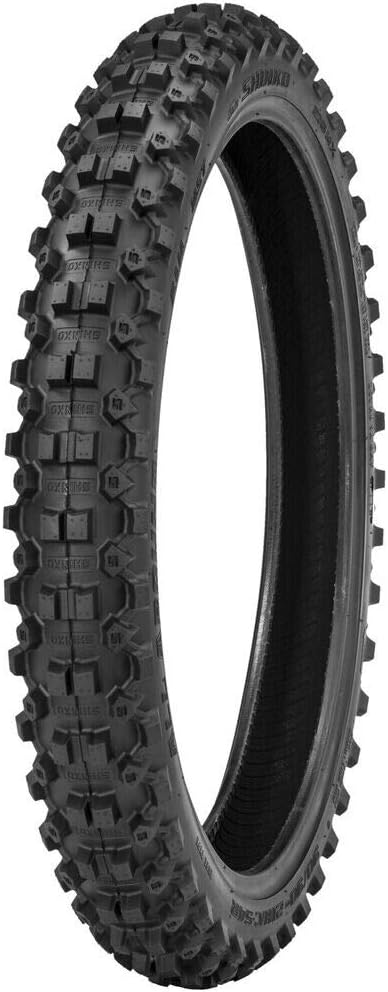Introducing the Shinko 216MX Fat Tire
Having already delved into the specifics of the Shinko 216MX Fat Tire in a previous review, where I compared its block size and other features to the Golden Tire 216 AAA, this article will focus more on the user experience. After eight months and using it as my fourth tire of this kind, I feel well-equipped to share both the strengths and weaknesses I’ve observed.
Balanced Size and Performance
One of the standout features of the Shinko 216MX Fat Tire is its size. It seamlessly complements the rear tires I’ve been using, particularly the 120 118s. These are relatively tall tires, and the front fat tire, being taller in size, harmoniously balances the rear one.
But there’s more to its size than just aesthetic symmetry.
Riding Over Rough Terrains
The increased height of the Shinko 216MX Fat Tire is a boon when navigating rocky terrains and forest floors laden with roots. The extra height provides a buffer, offering riders a noticeable cushioning effect, thereby minimizing direct impacts. On my journeys, I’ve found that maintaining a tire pressure of around 11 psi is optimal. This not only ensures a comfortable ride over rough surfaces but also helps in preventing pinch flats.
Puncture Resistance: A Noteworthy Feature
For any rider, the dread of a punctured tire in the middle of nowhere is real. With the Shinko 216MX Fat Tire, this is a concern that’s significantly alleviated. Over my usage, spanning three tires of this kind, I’ve encountered just one puncture. And even in that instance, it was caused by a sharp branch piercing the tire during an off-road escapade. Such resilience speaks volumes about the tire’s robust construction and its suitability for rugged terrains.
Shinko 216MX Fat Tire: A Terrain Versatility Assessment
The Shinko 216MX Fat Tire’s adaptability across a diverse range of terrains has been a subject of much interest. From my experience spanning ten days of intense riding, I’ve been able to gather some insights into its performance on different landscapes and its durability over time.
Tire Wear and Durability
Over a span of ten days, I subjected the tire to an array of terrains, from rugged trails to regular roads. Surprisingly, the wear has been commendably even, considering the demanding nature of the terrains I encountered. Upon inspection, the braking side appears slightly rounded, indicating wear from constant stops. However, the middle section and the non-braking side retain a substantial amount of tread, showcasing its lasting durability in diverse settings.
A Note on Side Lugs
While the tire’s overall performance has been commendable, I’ve noticed a specific wear pattern that’s worth mentioning. The side lugs of the tire tend to show signs of tearing after extensive use. On close examination, one can observe certain lugs being significantly torn, while others are just beginning to fray. Although this isn’t a significant concern for me, as I usually switch out the tire once it reaches this wear level, it’s something potential users might want to take into account. If one tends to wear down their tires considerably before considering a replacement, this might be an aspect to ponder upon.
In essence, the Shinko 216MX Fat Tire’s adaptability and endurance across varied terrains make it a worthwhile choice. However, a keen eye on its wear pattern, especially concerning the side lugs, can ensure riders get the best out of it.
Shinko 216MX Fat Tire: An Off-Road Delight
Exploring the vast world of off-road tires can often be a daunting task for many enthusiasts.
Among the myriad of choices, the Shinko 216MX Fat Tire has stood out as a noteworthy contender. Let’s delve deep into its performance across various terrains and its overall value proposition.
Unwavering Grip across Terrains
The Shinko 216MX Fat Tire’s most commendable feature is its impeccable grip. Whether it’s treacherous roots, slippery rocks, dense hard packs, or unpredictable mud terrains, this tire’s grip remains unwavering. One of the attributes that makes this tire a favorite among many is its predictability. Especially when making sharp turns, the tire’s response is consistent, preventing any abrupt loss of traction. This ensures a safer and more enjoyable riding experience.
Braking Efficiency and Versatility
Braking is a crucial aspect of any tire’s performance, and the Shinko 216MX Fat Tire doesn’t disappoint in this realm. I have personally tested it on my 250 XC two-stroke, which is relatively lightweight. The tire exhibited a commendable braking response, enhancing the bike’s overall safety and control. Moreover, the versatility of this tire shines through as it seamlessly adapts to heavier bikes. A few associates of mine, riding 4-stroke bikes like the robust 500 EXE, have echoed similar positive feedback on its performance across different weights and bike models.
Value for Money and Durability
In terms of its cost-to-performance ratio, the Shinko 216MX Fat Tire undoubtedly offers substantial value. It not only provides consistent and high-level performance but does so without burning a hole in the rider’s pocket. However, no product is without its imperfections. Over time, I’ve observed that the side knobs of this tire tend to wear out and tear, especially as they approach the end of their lifecycle. It’s crucial for riders to periodically inspect and monitor this wear to ensure optimal performance and safety.
Conclusion: A Tire Worth the Investment
When weighing the pros against the cons, the Shinko 216MX Fat Tire emerges as a clear winner in the off-road tire segment. With its reliable grip across challenging terrains, impressive braking efficiency, adaptability across bike models, and undeniable value for money, it’s a choice that many off-road enthusiasts would appreciate. The minor hiccup with the side knobs wearing out is easily overshadowed by its plethora of advantages. For anyone in pursuit of a high-performance off-road tire that promises a blend of safety, enjoyment, and affordability, the Shinko 216MX Fat Tire is a commendable recommendation.





